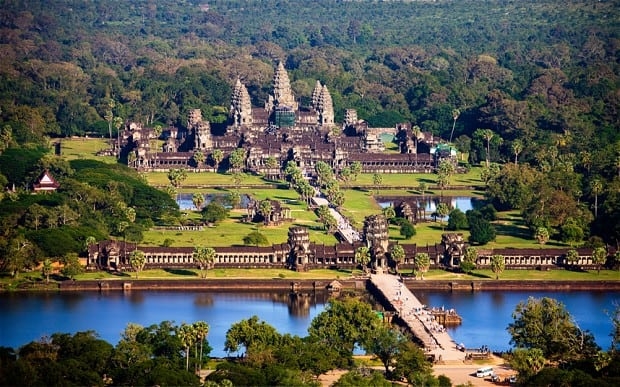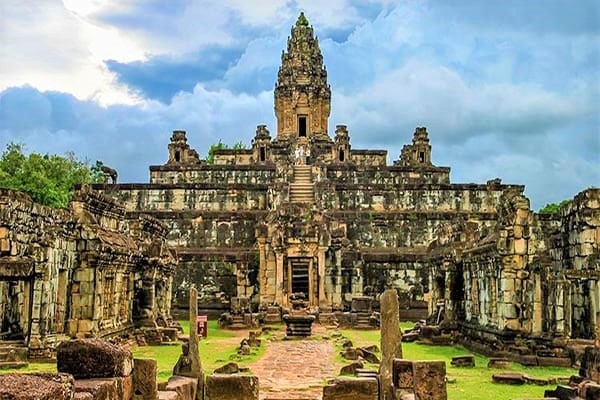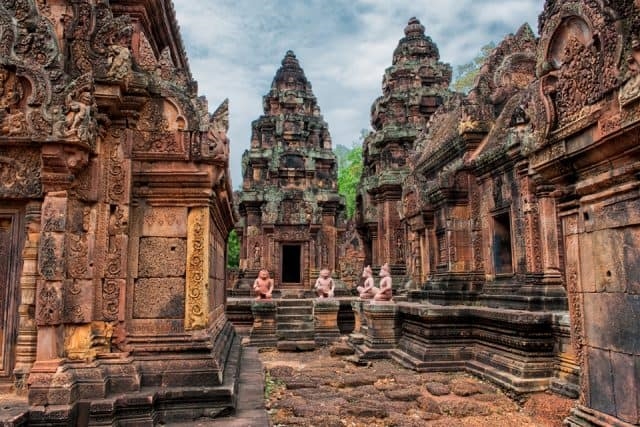Angkor temple complex - Wonder of the world in Cambodia
Located about 6 km north of Siem Reap, the Angkor Temple Complex was built by King Suryavarman II in the first half of the 12th century. The area of the whole complex extends over 248 square miles (400 km2), surrounding the temple is a deep and wide moat. Originally designed to worship Hinduism, but later due to the introduction and strong development of Buddhism, Angkor Wat was converted to worship Buddhism. The Angkor temple complex has over 1,000 temples of different sizes and shapes bearing Khmer architectural style. Famous temples are Angkor Wat and Angkor Thom, Bayon temple with countless sculptural decorations.
The Angkor temple complex has over 1,000 temples of different sizes and shapes bearing Khmer architectural style. Famous temples are Angkor Wat and Angkor Thom, Bayon temple with countless sculptural decorations.
The Angkor complex is influenced by ancient Khmer art with a unique architecture, highlighting Khmer artistic values. The entire architectural complex is outstanding and unique in ancient sculpture. The towers, temples, reliefs and vast corridors are all made from boulders, stacked on top of each other and look very natural, even on the roof of the dome. Decorative stone motifs such as Buddha statues, dancers, warriors and lotus images illustrating the epics Ramayana and Mahabharata are all very vivid and soft. The temple's architecture is modeled after India's great Mount Meru. The tallest central tower of up to 65m represents the legendary Mount Meru, and the five surrounding towers correspond to the five peaks of the mountain. This entire architecture is built of sandstone and honeycomb stone. All those big blocks of stone are stacked on top of each other without any adhesive or reinforced concrete at all.
The temple's architecture is modeled after India's great Mount Meru. The tallest central tower of up to 65m represents the legendary Mount Meru, and the five surrounding towers correspond to the five peaks of the mountain. This entire architecture is built of sandstone and honeycomb stone. All those big blocks of stone are stacked on top of each other without any adhesive or reinforced concrete at all.
Another extremely important element of Angkor is the irrigation system built over many dynasties. The region's irrigation systems rely on large reservoirs. These reservoirs not only help the lives of people in the area but also help develop the economic infrastructure of the capital Angkor. Below are 5 mysterious temples in the Angkor Monuments Complex: Angkor Wat is the temple with the most monumental architecture in the entire complex, with the main entrance facing west towards the setting sun. Angkor Wat Temple has 398 rooms, connected by 1,500m of corridors. Above, the 5 towers are interconnected with 3 architectural floors, of which the tallest tower is up to 65m, and the 4 sub-towers are 40m high. The road leading to the main gate of Angkor Wat is also made of boulders, 230m long, nearly 10m wide and 5m high above the lake water on both sides of the temple.
Angkor Wat is the temple with the most monumental architecture in the entire complex, with the main entrance facing west towards the setting sun. Angkor Wat Temple has 398 rooms, connected by 1,500m of corridors. Above, the 5 towers are interconnected with 3 architectural floors, of which the tallest tower is up to 65m, and the 4 sub-towers are 40m high. The road leading to the main gate of Angkor Wat is also made of boulders, 230m long, nearly 10m wide and 5m high above the lake water on both sides of the temple.  The entire temple complex still retains ancient traces with many images of stone carving art such as giant relief panels, columns, doors, ceilings, walls, corridors, railings, roofs..., all exuding the extraordinary strength and skillful hands of the ancient Khmer people.
The entire temple complex still retains ancient traces with many images of stone carving art such as giant relief panels, columns, doors, ceilings, walls, corridors, railings, roofs..., all exuding the extraordinary strength and skillful hands of the ancient Khmer people.
Angkor Thom is the powerful capital of the ancient Khmer capital. Angkor Thom possesses outstanding temples and architecture such as Bayon temple, Baphuon temple, Phnom Bakheng temple at the top of the hill, Elephant Terrace, Terrace of the Leper King and 5 large gates leading into Angkor Thom. Among them, Bayon Temple gives visitors the most impressive feeling, they are completely conquered by its exemplary and lively beauty. The temple is made up of 50 stone towers. Its core is an architectural complex built in a terraced style with 16 medium-sized stupas and many small towers linked together.
Among them, Bayon Temple gives visitors the most impressive feeling, they are completely conquered by its exemplary and lively beauty. The temple is made up of 50 stone towers. Its core is an architectural complex built in a terraced style with 16 medium-sized stupas and many small towers linked together. Little Circuit - this area has the most famous temple, the "ancient" Ta Prohm temple, where nature's creations blend with human works. The branches and roots of ancient trees grow together, covering the temple, creating a quaint scene, attracting tourists to Cambodia.
Little Circuit - this area has the most famous temple, the "ancient" Ta Prohm temple, where nature's creations blend with human works. The branches and roots of ancient trees grow together, covering the temple, creating a quaint scene, attracting tourists to Cambodia.
Big Circuit - this area also has a structure, Preah Khan temple, similar to Ta Prohm temple: Stone walls mixed with ancient tree stumps. In addition, Big Circuit also has an ideal sunset viewing spot, Pre Rup Temple. This is also a memorable experience that you should try when you set foot at Angkor Wat. The Rolous group is a complex of unique ruins belonging to the ancient city of Hariharalaya, older than Angkor, of which Bakong temple with its pyramid architecture is the most prominent.
The Rolous group is a complex of unique ruins belonging to the ancient city of Hariharalaya, older than Angkor, of which Bakong temple with its pyramid architecture is the most prominent. Peripheral temples - this area is located quite far from the center of Angkor Wat temple complex but has the most unique and different works. Banteay Srei Temple was built mainly of red sandstone, a pigment added to the elaborate decorative wall sculptures that are still visible today.
Peripheral temples - this area is located quite far from the center of Angkor Wat temple complex but has the most unique and different works. Banteay Srei Temple was built mainly of red sandstone, a pigment added to the elaborate decorative wall sculptures that are still visible today.















![[ℕ𝕖𝕧𝕖𝕣] 𝕊𝕖𝕝𝕝 𝕐𝕠𝕦𝕣 𝔹𝕚𝕥𝕔𝕠𝕚𝕟 - And Now What.... Pray To The God Of Hopium?](https://cdn.bulbapp.io/frontend/images/79e7827b-c644-4853-b048-a9601a8a8da7/1)















![[LIVE] Engage2Earn: Save our PBS from Trump](https://cdn.bulbapp.io/frontend/images/c23a1a05-c831-4c66-a1d1-96b700ef0450/1)















